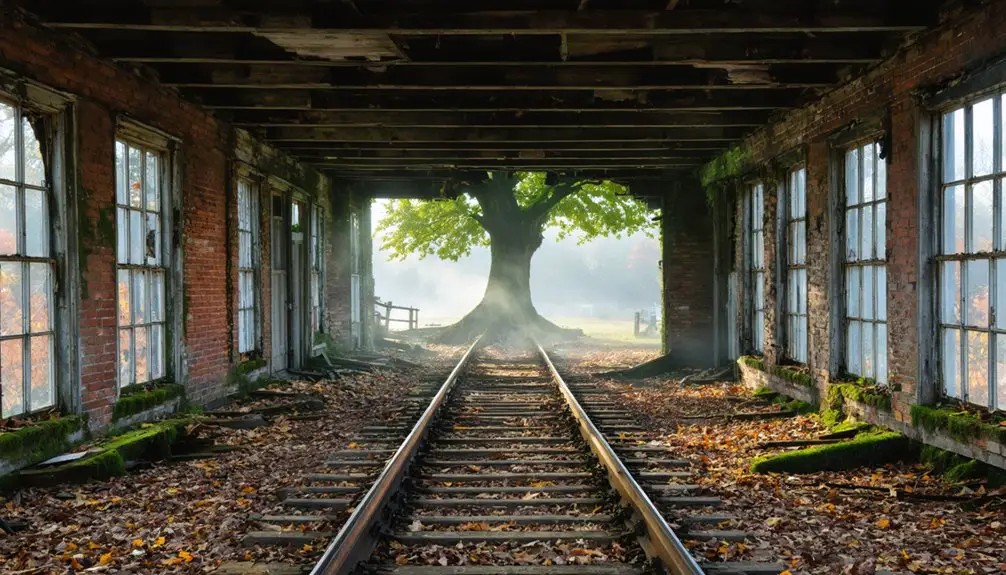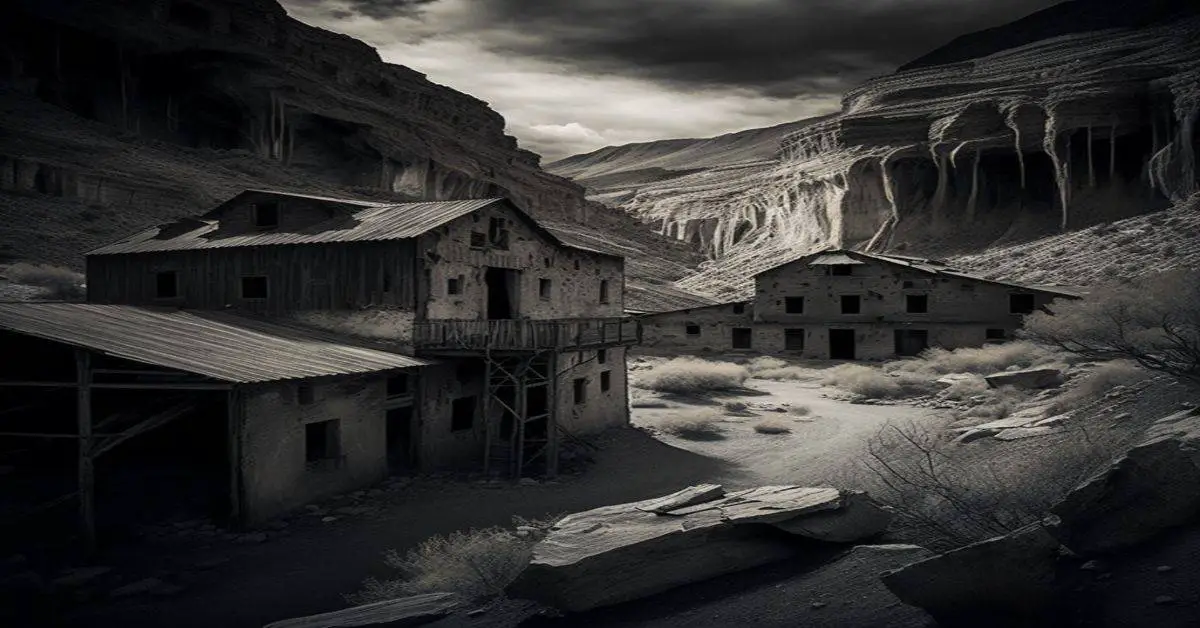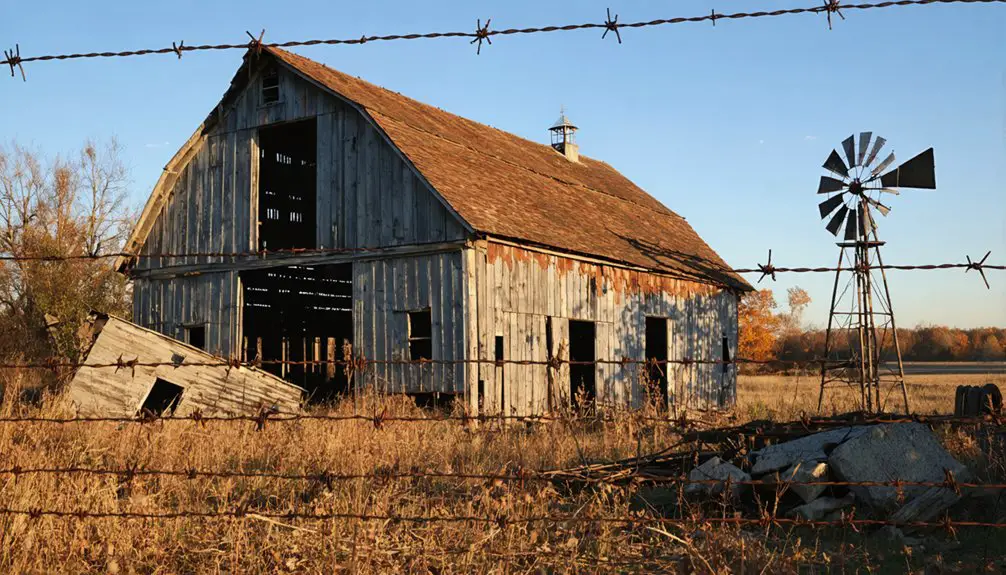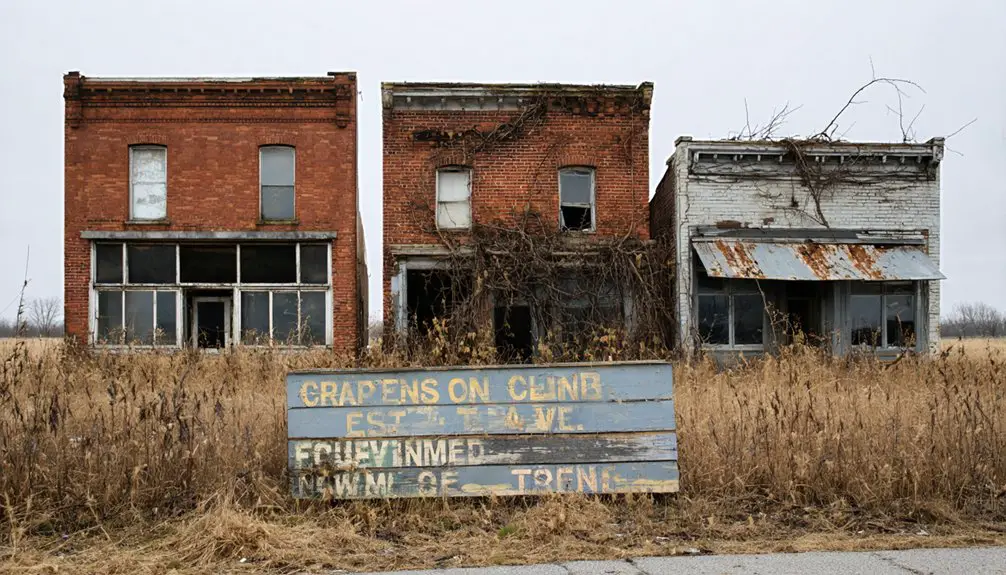You’ll find Boston, Ohio’s haunting transformation in Summit County, where a thriving 19th-century mill town became known as “Helltown” after federal intervention in 1974. Through eminent domain, the government forced residents to abandon their homes for the creation of Cuyahoga Valley National Park. This displacement sparked numerous urban legends, from supernatural sightings to tales of cult activity. The village’s Gothic Presbyterian church and abandoned structures hold stories that bridge historical fact and folklore.
Key Takeaways
- Boston, Ohio became a ghost town in 1974 when federal authorities used eminent domain to acquire land for Cuyahoga Valley National Park.
- The abandoned village earned the nickname “Helltown” due to its eerie atmosphere of boarded-up homes and military patrols.
- Once a thriving mill town and canal commerce hub, Boston’s forced evacuation left behind vacant structures and displaced families.
- Urban legends emerged about supernatural occurrences, including ghost sightings at Boston Cemetery and mysterious lights in abandoned streets.
- The village’s remains exist within Cuyahoga Valley National Park, featuring the historic Presbyterian church and other architectural remnants.
The Rise and Fall of a Historic Village
The historic village of Boston, Ohio emerged as a pivotal settlement in 1806, marking the beginning of organized community life in what would become Summit County.
You’ll find that the village economy initially centered around mills, with the first one built in the 1820s, setting the foundation for future industrial growth. When the Ohio & Erie Canal arrived, it transformed Boston into a bustling hub of commerce and attracted new residents seeking opportunity.
The construction of the Boston Mills railroad station in the 1880s further cemented the village’s industrial identity. Despite maintaining its modest size, Boston supported a thriving community with its Presbyterian church, school, and various mills. The forced evacuations left many residents feeling displaced and dispossessed of their ancestral homes.
The railroad arrival solidified Boston’s industrial spirit, as the small village flourished with its church, school and bustling mills.
Yet this stable existence would eventually give way to an unforeseen fate when federal intervention in 1974 forever altered the village’s destiny. The residents were forced to leave their homes through eminent domain as the area was incorporated into the Cuyahoga Valley National Park.
From Boston Mills to Helltown: A Dark Transformation
While Boston Mills maintained its official name, a darker identity emerged in the 1970s when government acquisition of local properties transformed this once-thriving village into what locals began calling “Helltown.”
You’ll find the nickname stemmed from the haunting sight of numerous abandoned homes, hastily boarded up after residents were forced to sell their properties at reduced prices to make way for the expanding Cuyahoga Valley National Park.
The eerie atmosphere of deserted streets and “Road Closed” signs fueled the rise of Boston Mills folklore.
Armed military patrols monitored the cleared neighborhoods, intensifying residents’ fear and distrust.
Helltown myths quickly spread through the region, with tales of supernatural occurrences, ghostly figures in Boston Cemetery, and mysterious cult activities.
Though these stories lack concrete evidence, they’ve become deeply woven into local culture, transforming this displaced community’s trauma into enduring legend.
The area’s dark reputation grew as visitors reported encounters with unexplained bright lights moving through the abandoned streets at night.
Government Takeover and Abandoned Dreams
Behind Boston’s transformation into “Helltown” lies a contentious federal intervention that forever altered this once-vibrant community.
In the 1970s, President Ford’s administration launched an aggressive land acquisition campaign, wielding eminent domain to seize private properties for the creation of Cuyahoga Valley National Park. A large number of structures were eventually boarded up completely, creating an atmosphere of abandonment throughout the area. The legislation passed in 1974 aimed to preserve forests and natural areas within the region.
You’d have witnessed entire neighborhoods emptied as government signs marked homes for seizure. The community displacement left deep wounds, with residents equating their forced relocation to historic indigenous removal.
While compensation was offered, the government’s plans stalled, leaving acquired properties to decay. Houses stood empty for years, some becoming training grounds for local firefighters.
The bitter sentiment of displaced families echoed in graffiti left behind: “Now we understand how the Indians felt” – a reflection of the raw emotions of a community torn apart by federal mandate.
Urban Legends and Supernatural Tales
As Boston’s empty buildings succumbed to decay, supernatural legends took root in the abandoned town’s fertile soil.
You’ll find satanic rumors swirling around the Presbyterian church’s Gothic crosses, while ghostly sightings at Boston Cemetery speak of a lonely spirit eternally waiting on a bench for loved ones who’ll never return.
Along Stanford Road – dubbed the “Highway to Hell” – you’ll discover dead-end streets that locals claim hide sinister cult activities. The steep and dangerous inclines have contributed to numerous fatal accidents over the years. Boston Village’s 1806 founding makes it the oldest settlement in Summit County.
A rusted school bus stands as evidence to urban legends of haunted vehicles, though it actually served as temporary housing.
Even environmental concerns spawned fantastic tales, with stories of chemical-mutated creatures and the legendary “Peninsula Python” emerging from the Krejci Dump.
These myths transformed Boston into “Helltown,” where every abandoned structure holds a dark secret.
Legacy in American Ghost Town History
Unlike the classic Western ghost towns born from dried-up mines and economic decline, Boston’s transformation into “Helltown” represents a unique chapter in American ghost town history.
You’ll find its cultural significance stems not from natural disasters or economic failures, but from federal land acquisition in the 1970s for environmental conservation.
Within Cuyahoga Valley National Park, Boston’s remnants tell a compelling story of how government policy reshaped communities in the name of preservation.
Boston Township’s abandoned structures echo the controversial choices made when preservation policies uprooted an established community for parkland protection.
The town’s architectural legacy, including its Presbyterian church with mysterious upside-down crosses, stands as a symbol to the tension between progress and preservation.
Boston’s story illustrates a dramatic shift in American values, where environmental impact considerations trumped centuries-old settlement rights, creating a modern ghost town unlike any other.
Frequently Asked Questions
Were Any Residents Compensated Fairly for Their Forced Relocation From Boston?
You’ll find limited evidence of relocation fairness, as records don’t show residents received adequate compensation matching their property values or covering community losses during the government’s forced displacement program.
What Happened to the Graves and Cemeteries When the Town Was Abandoned?
You’ll find most graves weren’t relocated – they remain under National Park Service protection. While some families voluntarily moved remains, most cemeteries were preserved in place, though they’ve become overgrown with time.
Did Any Original Boston Residents Ever Return to Visit Their Homes?
You’ll find scattered accounts of return visits by displaced residents seeking to revisit their memories, though official restrictions and “No Trespassing” signs made these pilgrimages difficult and largely undocumented.
How Many People Lived in Boston at the Time of Displacement?
Numbers don’t lie, but time blurs the truth. You’d find exact population demographics weren’t documented, though town history suggests roughly 1,000-1,500 people based on 378 homes acquired by 1975.
Are There Any Surviving Photographs of Boston Before Its Abandonment?
You’ll find surviving photos in historical archives, including images of the Presbyterian church, local landmarks, and daily life. Photographic evidence exists on platforms like Flickr Commons and regional library collections.
References
- https://allthatsinteresting.com/helltown-ohio
- https://www.americanhauntingsink.com/helltown
- https://www.atlasobscura.com/places/helltown-ohio
- https://colonialghosts.com/tale-of-helltown-ohio/
- https://www.youtube.com/watch?v=MqeHr-inQ08
- https://www.youtube.com/watch?v=NBJZghcuUZ8
- https://www.ghostsofohio.org/lore/ohio_lore_36.html
- https://www.bostontownship.org/ourtown.phtml
- https://www.grunge.com/1115843/helltown-ohio-lives-up-to-its-name-with-its-unsettling-past/
- https://3140news.com/7768/news/unveil-the-truth-of-helltown/



